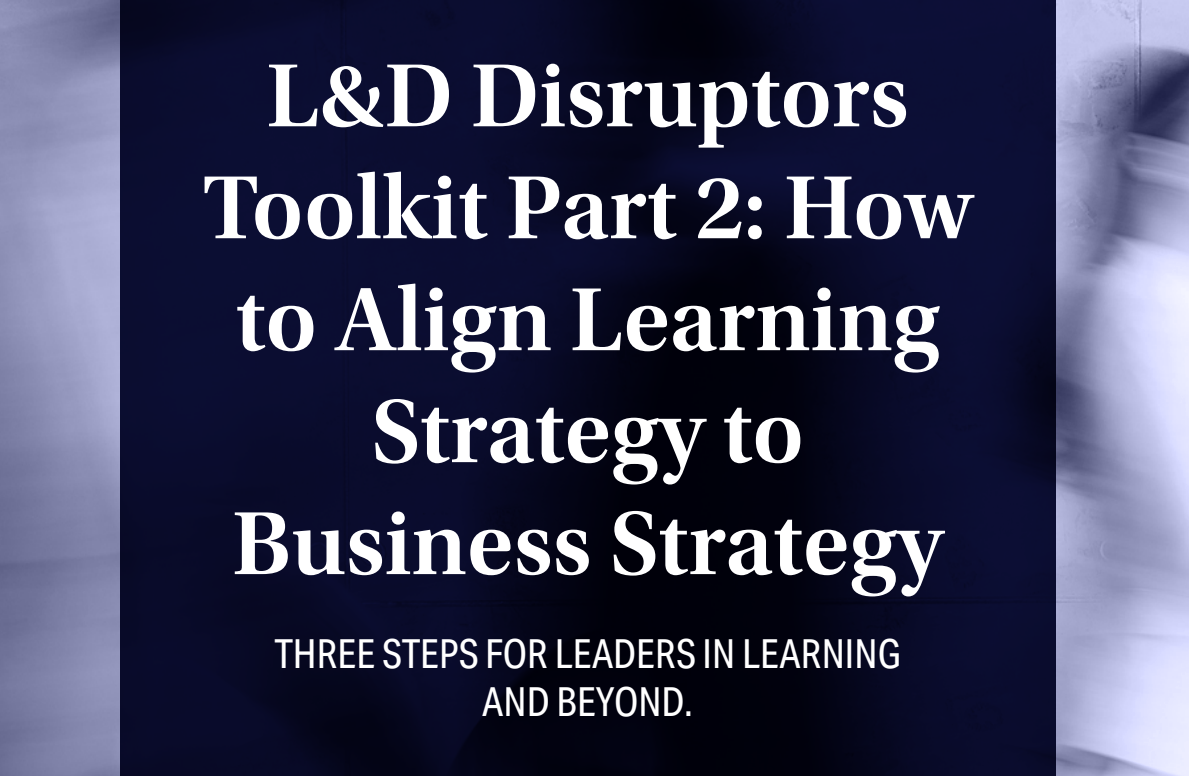L&D Disruptors Toolkit Part 2: How to align learning strategy to business strategy
Aug 14, 2024 by Robert M. Burnside

Aligning learning strategy to business strategy is one of the most important, and complex, skills a learning leader will develop throughout their career. We’d like to share some tips on how we’ve seen top learning leaders––across industries––hone and deploy this skill.
This post is part of our series on L&D disruptors. L&D disruptors are leaders who are changing the field of learning and deploying learning in forward-thinking ways––whether or not their title includes the word “learning.”
In this post, we explore the second of five “tools” every learning disruptor has in their toolkit. This one is all about aligning learning strategy to business strategy.
You’ll find a special sneak peek here, and you can get the rest of the guide by downloading your free copy.
Want more? Check out the first part of the toolkit, which covers how to sell learning internally. You can also take our quiz to discover if you’re an L&D disruptor, and learn more about the four traits of the L&D disruptor.
Introduction
Before we dive in, a caveat. It’s certainly important to understand the business and how to best support business goals through your learning strategy. That being said, it’s also important to see learning as a long-term process. And to be able to articulate that long-term vision of learning to leaders across the business.
This means that, although you should be able to point to specific metrics and tell the story of learning in a way that reflects current business priorities, it’s also your job as a learning leader to convey that the time horizon of results may be different from other business initiatives.
As one VP of learning at a large financial services firm told us, “Learning is a gradual process that requires time and patience. It involves building capabilities incrementally and should not be rushed for the sake of instant results.”
So, even as you advocate for learning’s strategic role in the wider business, don’t shy away from––as one learning disruptor we spoke with put it––“owning your power” as an L&D expert. Show how learning is essential to the business, but do it in a way that sets your company, and your learning initiative, up for success over the long term.
Now, let’s go through three steps that will help you align learning strategy to business strategy.
Step #1: To understand the business, diversify your inputs
Start with deeply understanding the business. The best way to build––or strengthen––this muscle is to diversify your inputs. What this looks like will depend on the nature of your business and your role. But a few inputs to consider include: meeting regularly with leaders from other functions, seeking out customer and client voices, finding learning disruptor mentors, and simply staying curious.
It’s also essential to make sure that you are consistently getting firsthand input from your target learners themselves. One learning disruptor we spoke with, a senior director of global talent development at a major clothing company, told us an anecdote that underscores the importance of this. Senior leaders were concerned about a new initiative where retail associates were to carry an AI-powered device that would help them answer customer questions. Would the associates get distracted by the device? Would they be staring at the screen rather than making eye contact with customers?
If these leaders had surveyed retail associates, they would have realized that their concerns were misplaced. Most of the associates had grown up using mobile phones from a young age, and were already adept at paying attention to customers while carrying a device.
This means that, while a learning solution built around these questions would have assuaged senior leaders’ concerns, it wouldn’t have addressed the needs of the associates on the ground.
As you’re assessing your inputs, make sure that you’re keeping them balanced so that you understand the long-term vision of the senior leaders and the real challenges faced by learners in their day-to-day work.
Diversify Your Inputs
Cross-Functional Leadership
- Task forces
- Listening tours
- Cross functional initiatives
- ERGs
Customer and Client Voices
- Recorded sales calls
- Market research
- Customer surveys
- Head to the field!
Learning Disruptor Mentors
- Industry groups
- Networking events & conferences
- Trade media
- LinkedIn & Slack groups
The Learners Themselves
- Pulse and summative surveys
- Interviews with champions and detractors
- Past learning data
This is a sneak peek of our guide on aligning your learning strategy to the business. In the rest of this guide, we’ll explore two more steps, including:
Step #2: Connect learning strategy to business strategy.
Step #3: Focus on the right outcomes.
To get the rest of the guide, including a list of questions to help you uncover key learning gaps and build your learning strategy around them, download your free copy by filling out this form!


-(1).png)
